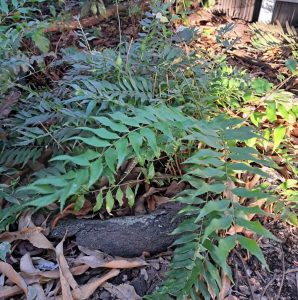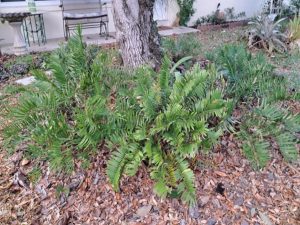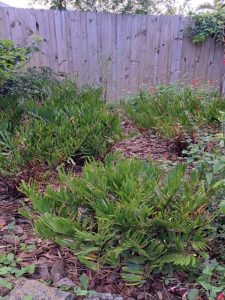In-A-Pinch Preventative Measures
The Other Cycads:

In my early years of Atala butterfly gardening I would panic during their peak caterpillar munching phase. Fearing I would run out of coonties, I planted other cycads to alleviate the strain on them. Of the many cycad species, the Atalas also lay eggs on the Zamia fischeri, native to Mexico. As with the coontie, they also like this plant when it is flush with tender new growth.
I later learned that the plant toxins in the other cycad species are not the same as in the coontie. Sometimes the caterpillars died as a result of eating the Zamia fischeri. In addition, the butterfly does not appear to show interest in the plant without new growth and ignores it the rest of the year. The Atala’s first choice is the coontie plant. In hindsight, it is best not to panic and provide them with more of what they prefer.
Egg Removal:
I find the most effective in-a-pinch remedy to prevent a population explosion is to remove some eggs from the coonties during the peak season. This remedy slows down and spaces out the time it takes the butterflies to go through their finite food source in the garden. Reducing the number of eggs on the coonties functions as a balancing act between the two and helps maintain the butterflies year-round.
Sandy Koi’s research on Atala butterflies influenced my decision to remove eggs. Her research found that each female can lay 60 or more eggs with a good percentage of them making it through the pupae stage. Multiply that by five or ten females and a population explosion can occur quickly. For this reason, I started conducting daily inspections of the new growth leaves during the spring and summer months and remove between 20 to 100 eggs per day. Ms. Koi’s research study is listed below.

I prefer the neighborhood to be filled with coontie plants, and my garden not be the isolated oasis in a suburban desert. In the meantime, my 50 plus coonties necessitate some balancing interventions to support Atalas year-round. A next-door neighbor is now smitten with the Atalas and purchased six coontie plants. I recently overheard her stressing about the caterpillars chewing her plants to stubs.
(UF/EDIS, Entomology and Nematology Department, Sandy Koi and Donald W. Hall, November 2015, publication number: EENY-641]
 3
3

